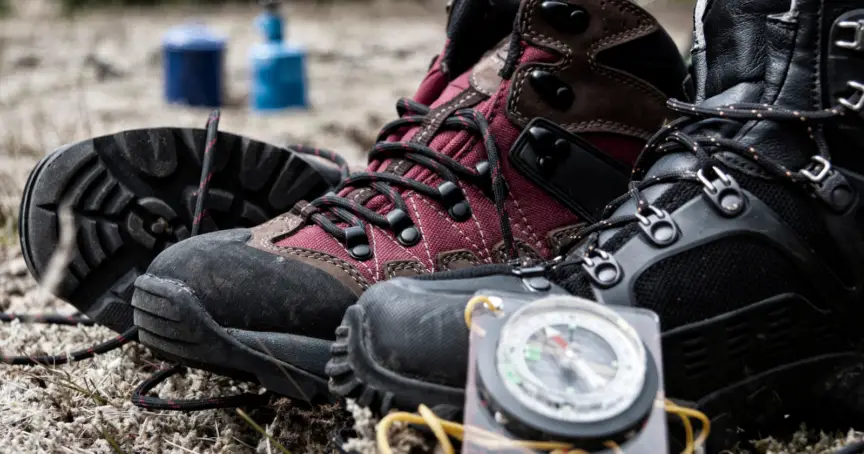ShoesandFitness.com is supported by our readers. We may earn a commission when you purchase through links on this page. Our content is checked for factual accuracy by our editorial team before being published.
When it comes to hiking, having the right gear can make all the difference in your experience. One of the most important pieces of gear for any hiker is a good pair of hiking boots. Hiking boots are designed to provide support, stability, and protection for your feet on rugged terrain. However, with so many options available, it can be difficult to know which pair is right for you. In this guide, we will discuss the different factors to consider when choosing hiking boots, including fit, material, and features. We will also provide tips for breaking in and maintaining your boots, to ensure that they last for many miles of hiking. Whether you are a seasoned hiker or just starting out, this guide will help you find the perfect pair of hiking boots for your next adventure.

How Should Hiking Boots Fit?
Hiking boots should fit snugly around the heel with enough room in the toe box to wiggle your toes. You should be able to lace them tightly without experiencing any pain or discomfort. When laced properly, your heel should not slip inside the boot while walking downhill and your toes should not be pushing against the front of the boot.
It’s also important to ensure that the boots fit properly with the socks and insoles you plan to wear while hiking. It is recommended to try on boots in the afternoon, as feet tend to swell during the day. It’s also recommended to walk around in the boots for a bit to ensure a good fit.
You Should Be Able to Lace Them Tightly
It is important to be able to lace hiking boots tightly in order to ensure a secure and stable fit. Lacing the boots tightly helps prevent your foot from sliding around inside the boot, which can cause blisters and discomfort. It’s important to make sure the boots fit snugly but not too tight, as this can cause pain and discomfort.
It’s also important to note that boots should be laced differently depending on the activity and the terrain, for example, tighter lacing is needed for steep descents, and looser for level terrain or ascent. It is always good to experiment with different lacing techniques to find the most comfortable and secure fit for your needs.

They Need to Fit with Socks and Insoles
It’s important to make sure that hiking boots fit properly with the socks and insoles that you plan to wear on your hike. When trying on boots, it’s best to wear the type of socks that you will be wearing on your hike, as different types of socks can affect the fit of the boots. Wearing thick hiking socks can make the boots feel tighter, while wearing thin socks can make them feel looser.
Insoles can also affect the fit, as they can take up space in the boots and change the shape of the footbed. It’s a good idea to try on boots with the insoles you plan to use to make sure they fit properly and provide the level of support and comfort you need.
Try on New Boots in the Afternoon
It is recommended to try on new hiking boots in the afternoon, as feet tend to swell during the day. Trying on boots in the morning when your feet are at their smallest can lead to a false sense of fit, and the boots may feel too tight or uncomfortable later in the day.
By trying on boots in the afternoon when your feet are at their largest, you can ensure that the boots will still fit comfortably and provide enough room for your feet to expand during a long hike. Also, If you can, it is a good idea to take the boots for a test walk around the store or outside to get a sense of how they feel when in motion.

Key Points on Breaking in Hiking Boots
Let’s take a look at some key points to consider when breaking in new hiking boots.
- Start by wearing your new hiking boots around the house for short periods of time to get used to the fit and feel.
- Gradually increase the amount of time you spend wearing the boots as your feet adjust.
- Take short walks or hikes on easy terrain before attempting more challenging hikes.
- Use a waterproofing treatment to protect the boots from water and sweat damage.
- Use a shoe insert for added comfort, and to provide a cushion for your feet
- Rotate your boots with other shoes to give them time to dry and rest after each hike.
- Use leather conditioner or mink oil to keep the leather supple.
- Use a boot stretching spray to help loosen tight spots or tight areas.
- Be patient and persistent, breaking in hiking boots can take time, but it will be worth it in the end for the comfort and fit.
Key Points on Maintaining Your Hiking Boots
You will also need to maintain your new hiking boots. Take a look at some points to consider below to get the most from your hiking boots.
- Clean your boots after each hike to remove dirt, debris, and sweat.
- Use a brush or cloth to wipe down the boots, and a damp cloth to clean off any stubborn stains.
- Dry your boots thoroughly before storing them.
- Use a waterproofing treatment to protect the boots from water and sweat damage.
- Store your boots in a cool, dry place away from direct sunlight or heat sources.
- Use leather conditioner or mink oil to keep the leather supple.
- Rotate your boots with other shoes to give them time to dry and rest after each hike.
- Inspect the boots regularly for any signs of wear and tear, and have them repaired or replaced if necessary.
- Keep an eye on the soles and if they show wear and tear, consider having them resoled.
- Consider using a boot tree to help maintain the shape of the boots.
- Stay proactive and take care of your boots will help them last longer and continue to keep your feet comfortable and protected.

How Should Hiking Boots Fit
In conclusion, choosing the right pair of hiking boots is essential for a comfortable and successful hiking experience. When shopping for hiking boots, it’s important to consider the fit, material, and features that are right for you. Breaking in and maintaining your hiking boots is also an important part of ensuring they last for many miles of hiking.
By following the tips outlined in this guide, you can ensure that your hiking boots will provide the support, stability, and protection you need for all your outdoor adventures. Remember to always be patient and persistent, breaking in and maintaining hiking boots takes time, but it’s worth it in the end for the comfort and fit. Happy hiking!
More Posts on Outdoor Footwear
Are Timberland Boots Good For Hiking

